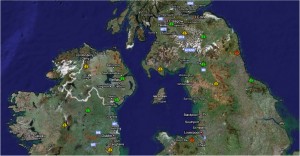January started with getting a new boss in $BIG_CORP who turned out to be one of the worst I’ve had – it’s one thing being a tough boss, it’s another thing treating second line support like first line support, depriving them of comforts they’d enjoyed for six months and altogether being ‘weak’. I was glad … Continue reading “2008 in review”
January started with getting a new boss in $BIG_CORP who turned out to be one of the worst I’ve had – it’s one thing being a tough boss, it’s another thing treating second line support like first line support, depriving them of comforts they’d enjoyed for six months and altogether being ‘weak’. I was glad to be rid of it, to be honest, though it gave me a few friends. January also had the Spice Girls gig over in the O2 – @dressjunkie and I took the train over from Belfast, down through Scotland and England and finally arrived in London, staying at the Britannia International – mere metres away from $BIG_CORP headquarters. That wasn’t entirely welcome. And in January we moved to our new house in Bangor.
February brought some welcome changes. $BIG_CORP decided to address some of the issues in their previous employee satisfaction survey and grouped people who cared about it into rooms for meetings in order to find out what was needed. In the end, they decided to do nothing about it so it was kinda wasted.
In March was Mike’s stag do. And the first meeting with my new boss’ boss. It went well enough – but it was evident that the company was in trouble. Bleeding people and sticking it’s head in the sand about it. I started planning an escape – it wasn’t enough to just leave, there were three team members who needed to be considered – so they were volunteered for development jobs elsewhere.
April brought me the news that $BIG_CORP didn’t care about the results of the study we were doing – they’d decided that the best way to deal with bad news in a survey was not to run a survey. This didn’t ruin my faith in the company – that had already gone. But it resolved me to make sure that I didn’t stick around.
Mid-May and I’d received notice of this Digital Circle role – it seemed like a good fit – it needed someone who had a background in digital media but who wasn’t necessarily a creator. As I’d had five years working in Mac support for most of the designers, TV companies, animators and media folks in the province – it seemed like a good fit.
In June, @dressjunkie decided that she’d had enough of her iPhone and really wanted to switch to a HTC Touch Diamond. We did so and it took three hours for her to confess that the Windows Mobile based device was but a poor shadow of the iPhone. And this was before the App Store opened. The Diamond was returned and the lesson learned. June also brought us BarCampBelfast which was fun.
July brought us the App Store and the iPhone 2.0 software upgrade. We were, of course, waiting for the Push stuff – which we’re still waiting for. I took five others down to Terryglass for OpenCoffee BBQ and paid out a small fortune to make it a fun trip. I also handed in my resignation to $BIG_CORP and the boss said I could take Garden Leave – woohoo – a month off. I also picked up my suit…
…because on the 1st August I got married to @dressjunkie. And on the 3rd August we left for our honeymoon. We drove down to London, did a little shopping in the big smoke, caught Wicked in the West End and drove through the darkness to Harwich, stayed the night in a motel and then, next morning, caught the boat. The next two weeks were spent being shipped around Northern Europe – six countries in twelve days. It was the best holiday I have ever had. I got back to discover that PJ and Phil, who met at my wedding, had written the Infurious Comic Reader while I was off gallivanting around the world. And then I started the new job…
September I attended IBC in Amsterdam and spent an afternoon sailing. I also attended the 25K Awards. The month itself was filled with meeting people working in the Digital Media space. I met some of the most interesting get-up-and-go-ers in the country. Infurious released EyeCandy #1 and we got some phone calls from some big companies who wanted to talk licensing. Naturally we said yes.
October brought more meetings, more events, training in Facilitation and techniques to inspire creativity and escaping the possibility of going to a networking event in Capetown.
In November, I visited Google, Microsoft, the National Digital Research Centre, the Media Cube at the Institute of Art, Design and Technology and the Digital Hub. There were a heap more meetings with some fabulous companies and startups in the province.
In December, all things kicked off. It’s been a tough month with deaths in the family, missed opportunities and failures. Christmas was good – but it was in spite of everything and not because of it. It was my first Christmas as
@dressjunkie‘s husband, my first in this new house, our home.


 I was inspired by
I was inspired by